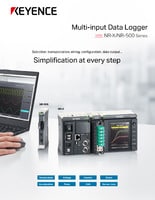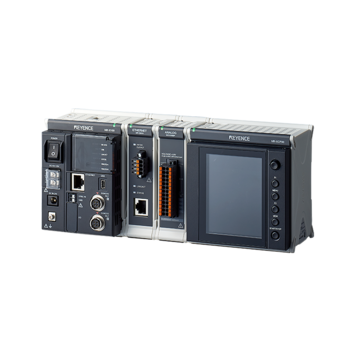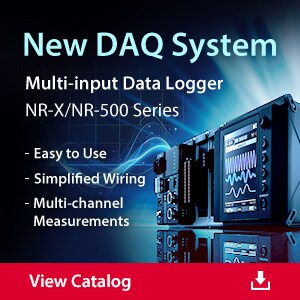Data Acquisition (DAQ)
Strain Measurement
This section defines strain and provides an easy-to-understand explanation of how to select a strain gauge and how to assemble a bridge circuit. This section also introduces key points for realizing accurate measurement and how to correct the gauge factor.
How to Measure Strain?
Strain measurement is key to material science, engineering, and manufacturing since it focuses on materials that deform under an applied force. The primary method of strain measurement is using data loggers or data acquisition systems and strain gauges.
Strain gauges are devices that convert the mechanical deformation of a particular material into an electrical signal, which is then processed by an NR-ST04 strain measurement unit and sent to a multi-input DAQ.
We’re here to provide you with more details.
Reach out today!

Advantages of Measuring Strain with Strain Gauges
Strain measurement using strain gauges has several distinct advantages. They’re incredibly accurate, which makes them invaluable to strain measurement applications such as precise engineering. On top of their precision, strain gauges are incredibly versatile and compatible with a wide variety of materials and structures.
When paired with a data acquisition system, strain gauges can be used for both real-time monitoring and stain measurement data logging, which is crucial for detecting potential failures. However, one of the most significant advantages of measuring strain with strain gauges is that they’re relatively inexpensive, especially considering the valuable data they provide.
Curious about our pricing?
Click here to find out more.

Types of Strain Sensors
Strain measurement typically relies on metallic strain gauges, as they’re most common, precise, and reliable. Semiconductor strain gauges offer increased sensitivity compared to metallic gauges, although they are susceptible to thermal fluctuations and typically come at a higher cost.
Deformation can also be measured using non-contact measurements such as confocal or triangulation displacement lasers, which typically measure a change in distance and can derive the strain measurement.
Discover more about this product.
Click here to book your demo.

Strain Measurement Devices
Strain gauges are the primary strain measurement devices for measuring strain, and their signal is output into an NR-ST04 for further processing, conditioning, noise removal, etc., before it’s sent into the NR-X Series multi-input data logger for storage and subsequent analysis, if necessary.
Get detailed information on our products by downloading our catalog.
View Catalog

Strain Gauge Measurements with KEYENCE DAQ Systems
KEYENCE offers comprehensive measurement solutions for measuring physical properties and processes, including the aforementioned NR-X Series data logger, which allows for real-time monitoring of data, a user-friendly interface, and advanced signal processing which ensures accurate conversion of resistance into strain values while also filtering out noise and accounting for temperature variance.
We’re here to provide you with more details.
Reach out today!

How to Choose the Right Strain Gauge
Choosing the right strain gauge involves considering several different factors. For example, the gauge material should be compatible with the test material to ensure reliable measurement, and it should be able to measure the expected range of strain without failure.
Thermal expansion and temperature conditions are also important as they can affect the measurement. So, the strain gauge has to be capable of withstanding the temperature conditions without affecting its performance; apart from these factors, size and sensitivity also matter.
The former matters as the gauge has to fit the available space on the material or structure being examined, and the sensitivity mostly depends on the precision requirement of your application. You might have to choose between a metallic gauge and a semiconductor one, considering the latter has greater sensitivity.
Curious about our pricing?
Click here to find out more.

How to Assemble a Bridge Circuit
A bridge circuit is a common and efficient way to measure strain in objects under various conditions. They can be assembled in multiple ways, such as the one-gauge, two-gauge, or four-gauge method, to measure different types of strain, including tensile, bending, and compressive. Additionally, temperature compensation and lead wire temperature compensation can be implemented to enhance the accuracy of the measurements further. Careful assembly and wiring are crucial in creating a functional and precise bridge circuit for strain measurement.
KEYENCE offers a comprehensive selection of various strain measurement solutions, so if you’re looking to upgrade your manufacturing process, you can trust that we have the right tools for the job. Contact us today to learn more about our strain measurement solutions and how we can help improve your productivity and efficiency.
Discover more about this product.
Click here to book your demo.



